#crossroadsuniversity
Text
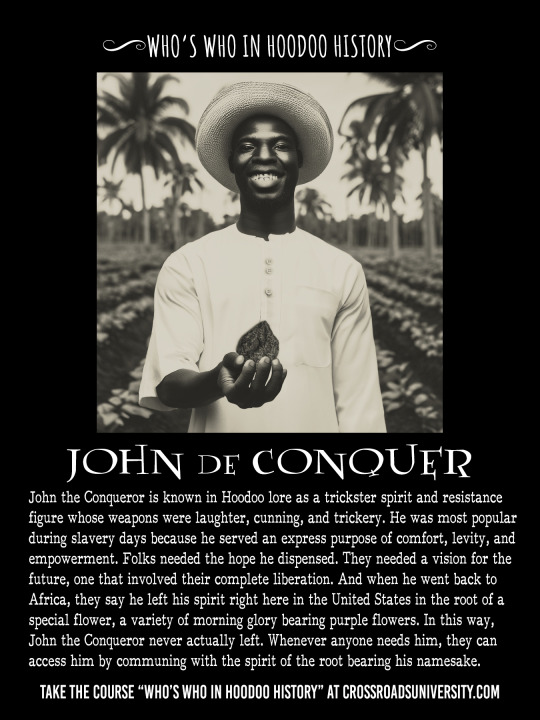
Who's Who in Hoodoo History: High John the Conqueror
John the Conqueror is known in Hoodoo folklore as a trickster spirit, always making a way out of no way at all, “hitting a straight lick with a crooked stick. Winning the jackpot with no other stake than a laugh” (Hurston 1943, 452). Slaves saw him as emerging from a whisper, finding laughter in sorrow, irony in tragedy, and triumph in despair. He was the bringer of hope, “the source and soul of our laughter and song.” He provided much-needed comedic relief in everyday life. He was a resistance figure whose weapons were laughter, cunning, and trickery.
They say that John was a prince who came from Africa, walking on the winds that filled the sails of ships through the Middle Passage. There are no photographs or drawings of the actual John the Conqueror. However, some say he resembled big John Henry, the “steel-driving man” of African American folklore. Or maybe he was “a little, hammered down, low-built man like the Devil’s doll-baby” (Hurston 1943, 452). Some say you can’t draw a spirit, so quit trying. Others say no one ever talked about what he looked like because it wasn’t necessary. White people never knew of his existence, which was by design; they weren’t supposed to know about him. He was the slaves’ biggest advocate on the downlow, and they lived for the tales of his putting one over on ole Massa.
They say that the spirit of John the Conqueror was around in the form of Brer Rabbit before John came on the scene. That wily mammal had already made the rounds on the plantations for a year and a day by the time John came along. Because he was in the form of an entertaining bunny, his tales spread far and wide. In reality, Brer Rabbit and John the Conqueror are two different spirits, but their functions are similar. Both are tricksters; both gain the edge through cunning, audacity, and intelligence. Both are empowering resistance figures.
John the Conqueror’s renown comes from the abundance of folktales describing his exploits. The most significant tales involve his role in procuring freedom through comedic relief and trickery. Freedom was of primary concern to John, and it governed near about all of his decisions. But he wasn’t the same kind of resistance figure as San Malo, Bras Coupe, or Annie Christmas. He was good at playing dumb when he needed to, and he excelled at the art of gaslighting. He played ole Massa like a fiddle.
He could make you think yellow was green and green was yellow. He would make you believe that what he did was your doing, and he was a master at leaving ole Massa standing in his place, mouth agape. He was just that cunning.
John the Conqueror was most popular during slavery days because he served an express purpose. People needed the kind of resilience and inspiration he could bring. They needed the hope he dispensed. They needed a vision for the future, one that involved their complete liberation. And when he went back to Africa, they say he left his spirit right here in the United States in the root of a special flower, a variety of morning glory bearing purple flowers. In this way, John the Conqueror never actually left. Whenever anyone needs him, they can access him by communing with the root bearing his namesake.
*Excerpt from Witch Queens Voodoo Spirits and Hoodoo Saints: A Guide to Magickal New Orleans.
Learn more about the OGs of Hoodoo:
https://www.crossroadsuniversity.com/courses/who-s-who-in-hoodoo-history
#hoodoo#conjure#rootwork#neworleansvoodoo#crossroadsuniversity#creolemoon#HighJohntheConqueror#JohnnyConker
245 notes
·
View notes
Text
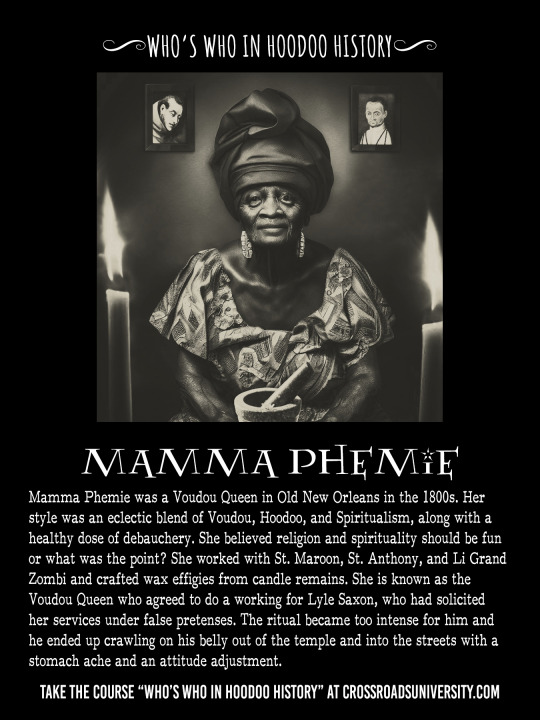
Who's Who in Hoodoo History: Mamma Phemie
Lyle Saxon said he’d always wanted to attend a Voudou ceremony and witness firsthand the sacred rites, but he’d never had the chance. Then, one day—under false pretenses—he got the opportunity.
Saxon had known an enslaved Congo man named Robert for years because Robert had worked for Saxon’s closest friends. In a happenchance meeting, Saxon told Robert some cockamamie story about being heartbroken because a rival stole his girlfriend. He said he wanted revenge on his enemy but was afraid to do anything himself. Of course, Robert took the bait and told Saxon he would take him to a Voudou woman to get it taken care of. So, that’s what they did. Robert took Saxon to see Mamma Phemie.
Mamma Phemie took Saxon through a variety of rituals that involved uncrossing. She had him unbuttoning, unclothing, and basically stripping down to nothing but a loose white robe wrapped around his body. She then prepared a parterre-type altar on the floor, characteristic of 19th-century hoodoo and Voudou. She recited a litany of Catholic prayers, and she experienced possession. Her style was an eclectic blend of Voudou, hoodoo, and spiritualism, along with a healthy dose of debauchery, if Saxon’s description is accurate.
To fix Saxon’s problem, Mamma Phemie said she would petition St. Maroon and Li Grand Zombi (the serpent god). To that end, she fashioned a poppet to represent Saxon’s rival out of black candle wax. After convincing him to cut himself so that she could have a blood offering to smear on the wax, she placed the effigy near the fire where the gumbo cooked in the center of the room. As the wax melted, Mamma Phemie began praying to Jesus, Mary, and Joseph. Then she recited the Act of Contrition. Suddenly, she stopped and yelled out: “Maroon!”
Her congregation followed suit, repeating “Maroon!” over and over again. Finally, one of her assistants brought to the parterre a statue of St. Anthony. As he set it down on the altar cloth next to Mamma Phemie, he said, “Done set de table, St. Maroon . . . now what yo’ goin’ to do?” Immediately the congregation broke out into the chant:
W’at yo’ goin’ to do? Oh, w’at yo’ goin’ to do?
Oh, Maroon, oh St. Maroon,
W’at yo’ goin’ to do?
According to Saxon, “there was no response from the sad-faced saint” (Saxon 1928, 317). Mamma Phemie’s attempt to summon the spirit intensified. She rose to her feet, assisted by a young girl whom Saxon dubbed “the mulatto girl,” and exclaimed: “Yo’ answer me, Maroon! What yo’ goin’ to do?”
Mamma Phemie stomped her foot and spat wine on the statue. In traditional New Orleans Voudou, this is more accurately described as spraying the image with wine to wake up the spirit. This is done by taking a sip of liquid—usually alcohol of some sort—and spraying the liquid out in a fine mist with the mouth. As Saxon didn’t know what he was looking at and wrote from an outsider’s perspective, the behavior sounds rude and vile. But it is not when explained in the appropriate cultural and religious context. This is done to bless objects, people, and spaces to prepare them for ritual activity.
Saxon observed Mamma Phemie go into a frenzy and ultimately into what he thought was an epileptic fit. Again, he was watching as an outsider who came under false pretenses with many preconceived ideas about the nature of Voudou, and he got it wrong. Of course, I was not there as a doctor who could determine whether she actually experienced an epileptic fit. I can say that if you have ever witnessed possession in the context of Voudou, it can look like an epileptic fit to the untrained, inexperienced eye. When the spirits are called down, those present at the ceremony may offer their bodies as “horses” for the spirits to “ride.” Mamma Phemie had been ridden by St. Maroon, evidenced by the exclamations of her congregants, “She done possess! She got ’er way! St. Maroon done answer ’er!” Her assistant added, “De sperrit done come strong on her!” (Saxon 1928, 318).
After Mamma Phemie came to, bowls of gumbo were passed out to congregants. Saxon was offered gumbo but didn’t want to eat it because he saw what he thought was a snake as one of the ingredients. Despite his initial revulsion, he forced himself to take a sip and immediately became sick to his stomach. He continued to watch the ceremony as more possessions began to take place. His anxiety mounted. He clearly did not understand what was going on. He described what he saw in sexual terms, noting how participants were scantily dressed, and “Mamma Phemie was shaking her breasts in rhythm to the drum” (Saxon 1928, 318).
Suddenly, she stood in the middle of the room and shouted: “Zombi!” Saxon then described men and women dropping to the floor writhing and moaning. This is an accurate description of people falling to the floor possessed by Li Grand Zombi. Li Grand Zombi is the primary serpent deity of New Orleans Voudou. The term can refer to the family of serpents in the New Orleans Voudou pantheon, as well. When folks are possessed by Zombi, they will writhe on the floor like a snake and hiss.
After a time, Saxon was given a gris gris designed to remedy his fake problem. “They handed me things that had been prepared for me,” Saxon reported. “A small bag containing ashes, hairs from a white horse’s tail, salt and pepper, and some crushed dried leaves; a box containing pecans which had been drilled with holes and in which feathers had been inserted; a bundle of feathers, wound around with dried grass” (Saxon 1928, 318).
Saxon was told to take the items he had been given and throw them one at a time in the path of his enemy. The feather bundle was to be put inside his rival’s pillow, while the pecans should be placed at his front door. When he next saw his enemy, he was told to throw some salt behind him as he left, which is believed to keep an unwanted person from returning. He was given an orange from St. Maroon’s altar to eat to provide him with strength. “It could not fail me now, for St. Maroon had blessed it. Had I not seen this miracle?” (Saxon 1928, 319).
Through this experience—one that he had the privilege of attending though doing so through deceptive means—Saxon maintained a special level of arrogance. His description of the ceremony moved from sexual to animalistic. He described attempted sexual assault, men biting women, and women being hurled halfway across the room. He said people were crashing against him in the dark, and wine was poured on him.
It wasn’t long before he ran like a little bitch out of the ceremony, sick to his stomach and scared to death. As he crawled on the floor toward the door, he reached desperately for his clothes and was spotted. Robert asked him if he was okay. All Saxon could do was a motion to let him pass.
“Out! I’m going out! Get out of the way!” he exclaimed.
One of the attendants standing guard outside took him by the arm and escorted him off the property, down an alley, and finally through a gate.
Saxon was so sick all he could do was lean against a lamppost. “Finally, the spasm of nausea passed, and I stagger along the dim streets, back toward a sane world which tells me that Voodoo no longer exists—if it ever existed!” (Saxon 1928, 322).
*Excerpted from Witch Queens, Voodoo Spirits, and Hoodoo Saints: A Guide to Magickal New Orleans
Explore the course, Who's Who in Hoodoo History to learn the stories of the OGs of Hoodoo. https://www.crossroadsuniversity.com/courses/who-s-who-in-hoodoo-history
235 notes
·
View notes
Text
Who's Who in Hoodoo History: Lige Broad Ax
Born in the late 1700s, Elisha Broadeaux, known as Lige Broad Ax, was brought to New Orleans from Cuba by a French planter. But it was in Kentucky where he earned his reputation as "the terror of Kentucky." The old Voudou priest preferred to be silent on the subject as he wanted to impress people with his declaration that he was 140 years old and would never die because he discovered the ELIXIR OF IMMORTALITY. Many folks asserted that the secret of his longevity was that he occasionally took the form of a vampire and repaired his shattered constitution with the blood of his younger victims. The power of old Lige to inhabit the bodies of animals at will was never disputed by those who knew him.

100 notes
·
View notes
Text
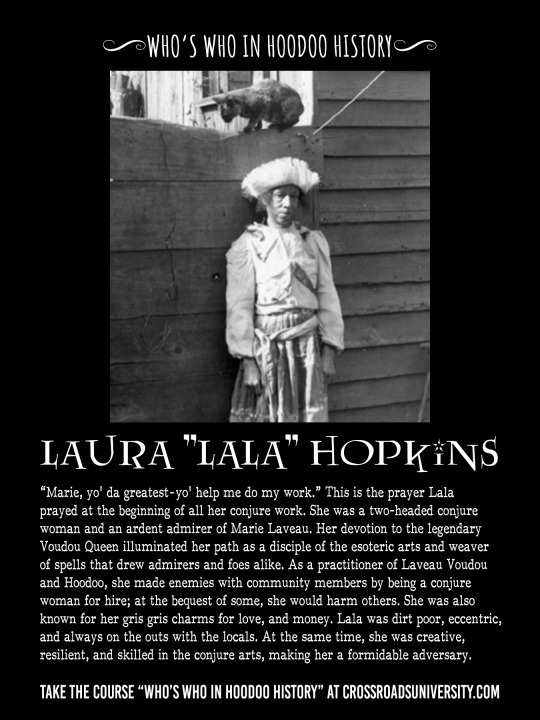
Who's Who in Hoodoo History: Laura "Lala" Hopkins
“Marie, yo’ da greatest—yo’ help me do my work.” This is the prayer Lala prayed at the beginning of all her conjure work. She was a two-headed conjure woman and an ardent admirer of Marie Laveau. Her devotion to the legendary Voudou Queen illuminated her path as a disciple of the esoteric arts and weaver of spells that drew admirers and foes alike. As a practitioner of Laveau Voudou and Hoodoo, she made enemies with community members by being a conjure woman for hire; at the bequest of some, she would harm others. She was also known for her gris gris charms for love, and money. Lala was dirt poor, eccentric, and always on the outs with the locals. At the same time, she was creative, resilient, and skilled in the conjure arts, making her a formidable adversary. Learn more: Who's Who in Hoodoo History (crossroadsuniversity.com)
#hoodoohistory#LalaHopkins#hoodooqueen#voodooqueen#neworleansvoodoo#conjure#rootwork#witchcraft#crossroadsuniversity#marielaveau#witches of color#witch community
84 notes
·
View notes
Text
Love and Sorcery: The Fate of Matilda Hailstork, Conjure Woman

Imagine getting sentenced three years in prison for practicing conjure like we do today because one of your clients is upset and takes you to court because a fixed candle they bought from you did not work. Matilda Hailstork's story from 1895 describes just such a scenario, only she fixed a dress, not a candle. This was the period in time when the terms Voudou and Hoodoo began to be used interchangeably and when practitioners began going underground. The public ceremonies and community rituals were rapidly disappearing.
Matilda Hailstork, a practitioner of "charms," "spells," and "hoodoo" medicine, was convicted of obtaining money by false representation and sentenced to three years in the penitentiary. One victim, Agnes Sheppard, testified that Matilda took a purple dress and fixed it to attract a man to Agnes, but the desired result did not occur. Matilda was acquitted on one charge but faced additional accusations, including obtaining items and money from other individuals, leading to her conviction on multiple counts.
To learn more about the famous, infamous, and obscure ancestors of Hoodoo, New Orleans Voudou, and conjure, check out the course Who's Who in Hoodoo History. https://www.crossroadsuniversity.com/courses/who-s-who-in-hoodoo-history
#hoodoo#rootwork#creolemoon#conjure#neworleansvoodoo#authordenisealvarado#crossroadsuniversity#new orleans voodoo#matildahailstork
43 notes
·
View notes
Text
Who's Who in Hoodoo History: Voudou Queen Eliza Nicaux

This is Eliza Nicaux, the Voudou Queen who took over when Marie Laveau stepped down in her elderly years. She was known for her charm-making and for having a black cauldron that she adorned with beads, feathers, and animal claws. Eliza Nicaux's charms were at once mysterious and effective, causing everyone to take pause when laying their eyes on one. Her work was just that powerful.
🪶
If you enjoyed this post, please check out my Patreon page: https://www.patreon.com/denisealvarado
🪶
If you would like to learn more about the ancestors of the Hoodoo, Voudou, conjure, and rootwork traditions, consider taking the course Who's Who in Hoodoo History where you will learn ALL the tea. Get to know the real people, the forgotten ones, the famous, and the infamous, foremothers and forefathers who passed down their knowledge to the tradition keepers of today. https://www.crossroadsuniversity.com/courses/who-s-who-in-hoodoo-history
45 notes
·
View notes
Text
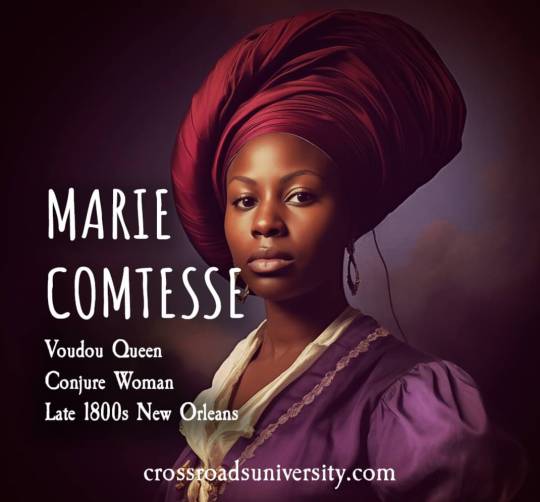
Who's Who in Hoodoo History: Marie Comtesse
Marie Comtesse was a trailblazer in the late 19th-century New Orleans Voudou scene, garnering remarkable acclaim for her mastery in the Voudou arts. Picture this: a formidable figure with a robust physique and piercing moon-shaped eyes that captured attention wherever she went. According to Voudou Queen Lala, Marie Comtesse was more than just a healer; she was a Queen, telling fortunes, securing employment for folks, and performing sacred works with unparalleled finesse. But that's not all—her attire was legendary! Draped in a majestic purple gown paired with a striking red tignon, she exuded power and mystique. And her conjure powders? Stored in a pristine white bag. But here's the captivating part: her ceremonies were a spectacle, akin to a dazzling stage production! Transforming her outfits like a skilled actress, she'd start in black, transition to white, and conclude in a mesmerizing blue ensemble. She wasn't just a spiritual leader; she was a vision, captivating male gazes with her jet-black allure and stunning fashion sense. And let's talk about her ceremonies - she glamoured her congregation by employing youthful, stunningly beautiful, Creole women dancers, igniting the imaginations of onlookers. Marie Comtesse had exceptional knowledge of powders and roots, acquired when she was a member of Marie Laveau’s congregation.
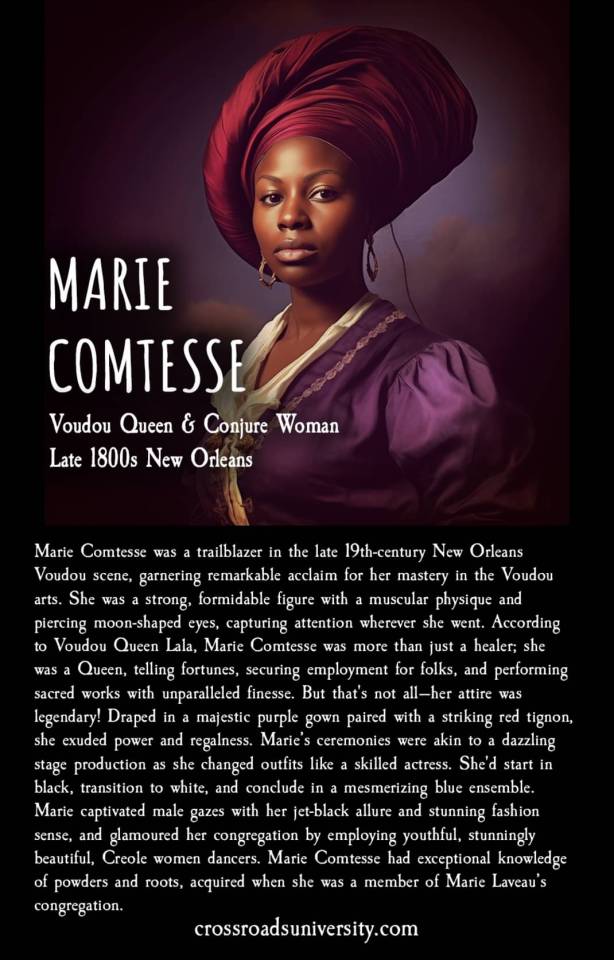
If you enjoyed this post and would like to support my endeavors for documenting these amazing people in Hoodoo history in the form of a book and cards, please check out my Patreon page: https://www.patreon.com/denisealvarado
If you would like to learn more about the ancestors of the Hoodoo, Voudou, conjure, and rootwork traditions, consider taking the course Who's Who in Hoodoo History where you will learn ALL the tea. Get to know the real people, the forgotten ones, the famous, and the infamous, foremothers and forefathers who passed down their knowledge to the tradition keepers of today. https://www.crossroadsuniversity.com/courses/who-s-who-in-hoodoo-history
#hoodoo#rootwork#conjure#neworleansvoodoo#creolemoon#witchcraft#authordenisealvarado#crossroadsuniversity#new orleans voodoo#whoswhoinhoodoohistory#marielaveau
36 notes
·
View notes
Text

Meet the ancestors of Hoodoo and New Orleans Voudou in the special course Who's Who in Hoodoo History. The course also covers figures in Spiritualism, Pow Wow, Granny Witches, Cajun traiteurs, Indian doctors, and notorious characters of the magickal arts who found themselves on the wrong side of the law. Its more than you could ever imagine. Check out the content - over 200 lessons with profiles and stories of these amazing people - and all lessons are not shown so there are some surprises. www.crossroadsuniversity.com - passing down the root, one course at a time.
#hoodoo#conjure#rootwork#creolemoon#neworleansvoodoo#marielaveau#authordenisealvarado#crossroadsuniversity#new orleans voodoo#witchcraft
28 notes
·
View notes
Text

20 notes
·
View notes
Text
Who's Who in Hoodoo History: Julia Jackson, Voudou Queen of New Orleans.
🪶🪶🪶
Julia Jackson was a notable Louisiana Voodoo practitioner hailing from New Orleans. Alongside Lala, she held a prominent position as a Voudou queen during the 1940s. Julia specialized in creating and selling gris-gris, charms, and potions. She had a unique skill of crafting her own amulets, talismans, and ingredients, using a range of curious components like nails, earthworms, coffee grounds, chicken feathers, red pepper, and even beef tongue.
🪶🪶🪶
Remember Hoodoo and Voudou are not necessarily separate traditions in New Orleans. In the 1800s and early 1900s, the two terms were used interchangeably. In addition, when looking at the core practices of Hoodoo, we see them in New Orleans Voudou. Crossing and uncrossing, foot track magic, curing, spiritual baths, and more are shared practices in both traditions. These practices can be traced to Betsy Toledano, Marie Laveau, Doctor John, and Julia Jackson and all of the Hoodoo, conjure and Voudou practitioners. I write about this in my book, the Magic of Marie The Magic of Marie Laveau if you are interested in learning more. You can also enroll in my free course Intro to New Orleans Voudou at Crossroad University or deep dive with the Foundations of New Orleans Voudou course to learn more.
🪶🪶🪶
If you enjoyed this post and would like to support my endeavors for documenting these amazing people in Hoodoo history in the form of a book and cards, please check out my Patreon page: https://www.patreon.com/denisealvarado
🪶🪶🪶
If you would like to learn more about the ancestors of the Hoodoo, Voudou, conjure, and rootwork traditions, consider taking the course Who's Who in Hoodoo History where you will learn ALL the tea. Get to know the real people, the forgotten ones, the famous, and the infamous, foremothers and forefathers who passed down their knowledge to the tradition keepers of today. https://www.crossroadsuniversity.com/courses/who-s-who-in-hoodoo-history
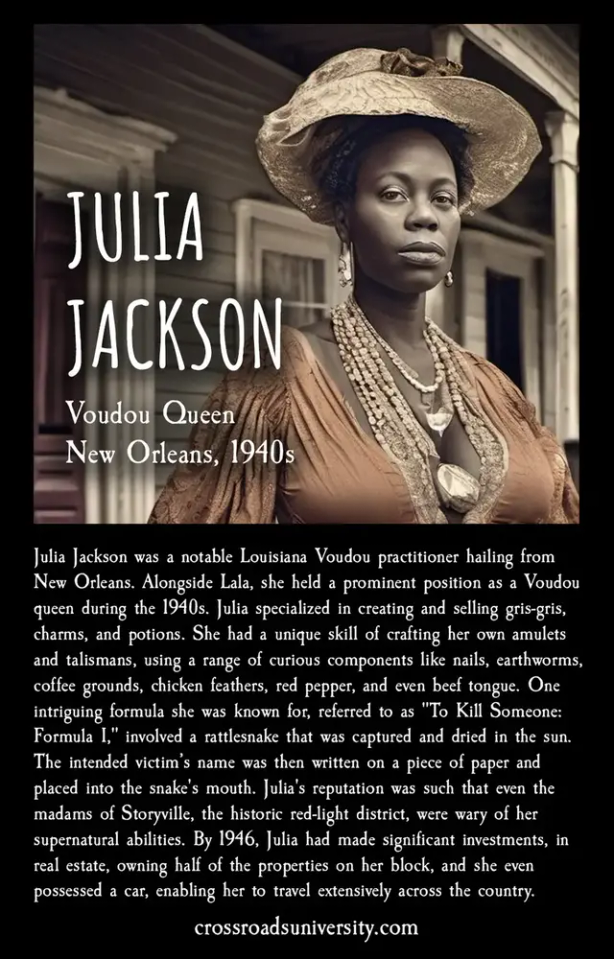
#whoswhoinhoodoohistory#hoodoo#conjure#rootwork#creolemoon#neworleansvoodoo#crossroadsuniversity#witchcraft#marielaveau#authordenisealvarado#juliajackson#voudouqueen
23 notes
·
View notes
Text
Traditional resistance fighters and magickal resistance fighters both play integral roles in challenging oppressive systems, yet they operate in distinct realms that are mutually reinforcing. Traditional resistance fighters engage in physical, tangible acts of defiance, often involving strategic planning, armed struggle, or advocacy to effect societal change. On the other hand, magickal resistance fighters operate in the realm of metaphysics, wielding beliefs, rituals, and spiritual practices to combat injustice on an energetic or supernatural level. While traditional resistance fighters address immediate, visible manifestations of oppression, magickal resistance fighters operate on subtle planes, influencing energies, intentions, and the collective consciousness. Both are necessary: the former for tangible impact and visible change, and the latter for the transformation of deeper, underlying energies and paradigms that sustain oppressive structures. Together, they form a symbiotic relationship, as the tangible efforts of traditional resistance fighters can be enhanced by the metaphysical interventions of magickal resistance fighters, creating a more comprehensive approach toward societal transformation.
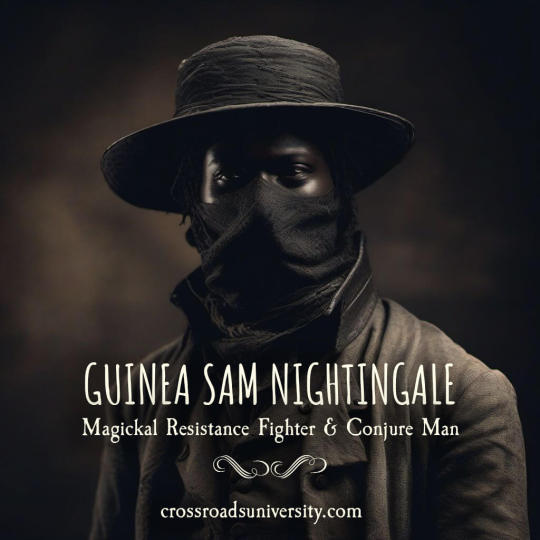

#guineasam#hoodoo#conjure#rootwork#creolemoon#neworleansvoodoo#crossroadsuniversity#new orleans voodoo
15 notes
·
View notes
Text
https://www.crossroadsuniversity.com/courses/who-s-who-in-hoodoo-history
Honoring the ancestors of the hoodoo, Voodoo, conjure, and rootwork traditions. Get to know the real people, the forgotten ones, the famous, and the infamous, foremothers and fathers who passed down their knowledge to the tradition keepers of today. Sign up today and be informed. 🪄
#hoodoo#rootwork#conjure#neworleansvoodoo#witchcraft#marielaveau#authordenisealvarado#crossroadsuniversity#whoswhoinhoodoohistory#hoodoohistory
7 notes
·
View notes
Text
Who's Who in Hoodoo History: William Wells Brown
William Wells Brown (circa 1814-1884) was a formerly enslaved man and an abolitionist who documented Hoodoo practices of enslaved people in St. Louis in two of his books. Brown was born enslaved in Kentucky. In 1827 Brown’s enslaver, Dr. John Young, moved near St. Louis, Missouri, and established a small farm. Dr. Young hired out Brown to work in the city of St. Louis for steamboat captains and local merchants. During his years enslaved in St. Louis, Brown saw conjure practices of enslaved people that he documented years later in his autobiographies after he escaped from slavery on the Underground Railroad.
https://www.crossroadsuniversity.com/courses/who-s-who-in-hoodoo-history
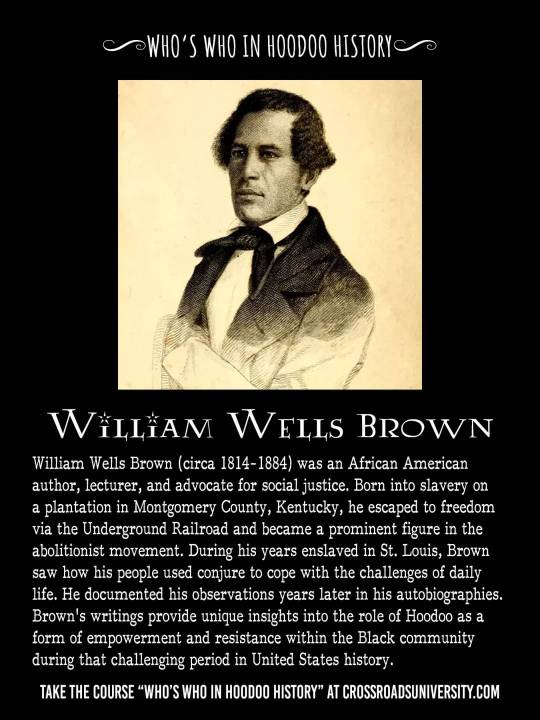
19 notes
·
View notes
Text
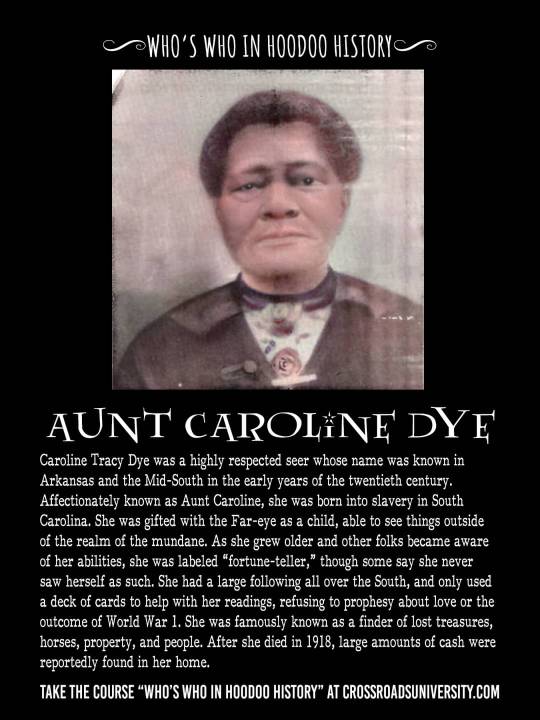
Who's Who in Hoodoo History: Aunt Caroline Dye
Caroline Tracy Dye (1843? –1918), better known as Aunt Caroline Dye, was born into slavery in South Carolina. She was gifted with the Far-eye as a child, able to see things outside of the realm of the mundane. As she grew older and other folks became aware of her abilities, she was labeled “fortune-teller”, though some say she never saw herself as such.
Aunt Caroline Dye was a highly respected seer whose name was recognized in Arkansas and the Mid-South in the early years of the twentieth century. She was born into slavery in Spartanburg, South Carolina, about 1843—there is conflicting information through the years about her date of birth and early life. According to Craig (2009): “Caroline Tracy became aware of her abilities as a seer while still a young child. She could reportedly see things outside her line of vision that others could not.”
Aunt Caroline had a large following from all over the south and in particular from Tennessee. According to Craig (2009) she only used a deck of cards to help with her readings, and she refused to give readings about love or the outcome of World War 1. “She did, however, tell many people the location of strayed or stolen livestock, sometimes giving specific directions, and she helped people locate missing jewelry. She gave visions of the future for her clients and offered advice on missing persons” (Craig, 2009). It was after Dye moved to Newport (Jackson County) that her reputation began to grow. She never claimed to be a fortune teller; that title was given to her by others. Her clients were both Black and White, and most showed their appreciation by paying her a few dollars for a reading, although payment was not required. Dye reported that she received twenty to thirty letters a day, with most including money for her services. It was said that some prominent White businessmen of Jackson County would not make important decisions before consulting her. All day long, people crowded into her home in Newport waiting for a reading. She took advantage of the large number of visitors and sold meals from her house. Dye reportedly only used a deck of cards to help her concentration and would not give readings about love or the outcome of World War I; she did, however, tell many people the location of strayed or stolen livestock, sometimes giving specific directions, and she helped people locate missing jewelry. She gave visions of the future for her clients and offered advice on missing persons. Dye died on September 26, 1918, in Newport. After her death, large amounts of cash were reportedly found in her house. She is buried in Gum Grove Cemetery in Newport next to her husband, who had died in 1907.
Over the years, Aunt Caroline Dye's legend has grown to describe her as seer to hoodoo woman, two headed doctor, fortune teller, psychic and conjure doctor.
Learn more about the OGs of Hoodoo: https://www.crossroadsuniversity.com/courses/who-s-who-in-hoodoo-history
16 notes
·
View notes
Photo

Conjure Club 2! Check out the website for details! Sign up any time, complete at your own pace, certificate of completion from crossroadsuniversity.com. Free forums! #crossroadsuniversity #masterclass #hoodoo #conjureclub #conjure #witchcraft #witchyclasses #neworleansvoodoo #rootwork #instagood Sign up here>>>crossroadsuniversity.com (at Saint Johns, Arizona) https://www.instagram.com/p/Cm9v84QAcXd/?igshid=NGJjMDIxMWI=
#crossroadsuniversity#masterclass#hoodoo#conjureclub#conjure#witchcraft#witchyclasses#neworleansvoodoo#rootwork#instagood
4 notes
·
View notes
Photo

Conjure Club 1, the only one of its kind! Sign up any time, complete at your own pace, certificate of completion from crossroadsuniversity.com. Free forums! #crossroadsuniversity #masterclass #hoodoo #conjure #witchcraft #witchyclasses #neworleansvoodoo #rootwork #instagood Sign up here>>>crossroadsuniversity.com (at Saint Johns, Arizona) https://www.instagram.com/p/Cm9vj5CAR9R/?igshid=NGJjMDIxMWI=
#crossroadsuniversity#masterclass#hoodoo#conjure#witchcraft#witchyclasses#neworleansvoodoo#rootwork#instagood
4 notes
·
View notes